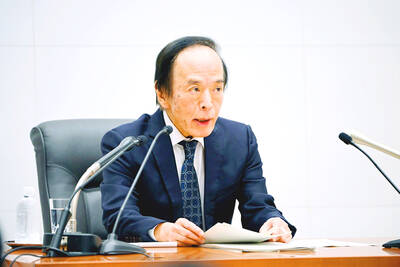China’s runaway property market cooled slightly last month, as authorities rolled out further home-buying curbs to deflate a housing bubble.
New-home prices, excluding Chinese government-subsidized housing, gained last month in 62 of the 70 cities tracked by the government, compared with 63 in September, the Chinese National Bureau of Statistics said yesterday.
Prices dropped in seven cities, compared with six a month earlier. They were unchanged in one.
PROPERTY CURBS
Some local authorities have stepped up property curbs, following a raft of restrictions rolled out in almost two dozen cities since late September.
Eastern Hangzhou ruled more non-local buyers ineligible last week, two months after halting purchases for some non-local residents.
China’s banking regulator has told banks to review their mortgage lending and property development loans after China Minsheng Banking Corp (中國民生銀行) suspended approvals of some non-standard mortgages in Shanghai.
Home prices in first-tier and red-hot second-tier cities “apparently” stabilized in the second half of last month after those regions announced fine-tuned curbs, the statistics bureau said.
Five cities, from Beijing to Xiamen, snapped a streak of price gains, the bureau said.
New-home prices in Shenzhen, the nation’s hottest property market earlier this year, fell 0.5 percent from September, the first decline in two years, the data showed.
Prices in Beijing fell 0.4 percent in the second half of last month, and declined 0.1 percent in Shanghai.
HOUSING BUBBLE
“Buyers and developers are now taking to the sidelines, creating a standoff in the market,” said Xia Dan (夏丹), a Shanghai-based analyst at Bank of Communications Co (交通銀行).
A cooling of the property market might provide some relief to policymakers, who are seeking to avoid a housing bubble without denting economic growth. Even amid curbs in major cities, property development investment rose 13 percent from a year earlier last month, the most since at least last year, according to Bloomberg calculations based on official data released on Monday last week.
New housing starts, an early indicator of real-estate investment, gained 20 percent from a year earlier, the biggest increase since April.
The Chinese Ministry of Housing and Urban-Rural Development has stepped up oversight of rogue players since early last month, investigating developers and agents for alleged false advertising, urging probes on “illegal” sales and cracking down on investment by online finance and peer-to-peer lenders.

Taiwan Semiconductor Manufacturing Co (TSMC, 台積電) last week recorded an increase in the number of shareholders to the highest in almost eight months, despite its share price falling 3.38 percent from the previous week, Taiwan Stock Exchange data released on Saturday showed. As of Friday, TSMC had 1.88 million shareholders, the most since the week of April 25 and an increase of 31,870 from the previous week, the data showed. The number of shareholders jumped despite a drop of NT$50 (US$1.59), or 3.38 percent, in TSMC’s share price from a week earlier to NT$1,430, as investors took profits from their earlier gains

In a high-security Shenzhen laboratory, Chinese scientists have built what Washington has spent years trying to prevent: a prototype of a machine capable of producing the cutting-edge semiconductor chips that power artificial intelligence (AI), smartphones and weapons central to Western military dominance, Reuters has learned. Completed early this year and undergoing testing, the prototype fills nearly an entire factory floor. It was built by a team of former engineers from Dutch semiconductor giant ASML who reverse-engineered the company’s extreme ultraviolet lithography (EUV) machines, according to two people with knowledge of the project. EUV machines sit at the heart of a technological Cold

TAIWAN VALUE CHAIN: Foxtron is to fully own Luxgen following the transaction and it plans to launch a new electric model, the Foxtron Bria, in Taiwan next year Yulon Motor Co (裕隆汽車) yesterday said that its board of directors approved the disposal of its electric vehicle (EV) unit, Luxgen Motor Co (納智捷汽車), to Foxtron Vehicle Technologies Co (鴻華先進) for NT$787.6 million (US$24.98 million). Foxtron, a half-half joint venture between Yulon affiliate Hua-Chuang Automobile Information Technical Center Co (華創車電) and Hon Hai Precision Industry Co (鴻海精密), expects to wrap up the deal in the first quarter of next year. Foxtron would fully own Luxgen following the transaction, including five car distributing companies, outlets and all employees. The deal is subject to the approval of the Fair Trade Commission, Foxtron said. “Foxtron will be

INFLATION CONSIDERATION: The BOJ governor said that it would ‘keep making appropriate decisions’ and would adjust depending on the economy and prices The Bank of Japan (BOJ) yesterday raised its benchmark interest rate to the highest in 30 years and said more increases are in the pipeline if conditions allow, in a sign of growing conviction that it can attain the stable inflation target it has pursued for more than a decade. Bank of Japan Governor Kazuo Ueda’s policy board increased the rate by 0.2 percentage points to 0.75 percent, in a unanimous decision, the bank said in a statement. The central bank cited the rising likelihood of its economic outlook being realized. The rate change was expected by all 50 economists surveyed by Bloomberg. The